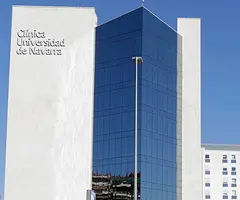Wilms' Tumor or Nephroblastoma
"The combination of surgery, pre- and post-operative chemotherapy and post-operative radiation therapy has made survival in these patients very high".
DR. JOSÉ MANUEL MORENO
CODIRECTOR. PEDIATRICS DEPARTMENT

What is Wilm´s tumour?
Wilms' tumour, also known as nephroblastoma, is a type of malignant cancer that develops in the kidneys and mainly affects young children, being the most common kidney cancer in this population.
More than 80% of Wilms' tumours occur in children under 5 years of age and are very rare in children over 15 years of age. In addition, in 20% of affected children, there are previous congenital malformations in the urinary tract. Wilms' tumour is a curable disease in most cases, with 5-year tumour survival rates above 90%.
At the Clínica Universidad de Navarra Cancer Centre we have a Paediatric Cancer Department, with more than 25 years' experience, which deals with all malignant pathologies affecting children and adolescents.

A PERSONALIZED MEDICINE
Second Opinion,
peace of mind
Request a second opinion from our professionals with great experience in the diagnosis and treatment of oncological diseases
In 3 days, without leaving home.
Symptoms of Wilms' tumour
Palpable abdominal mass
This is the most common symptom. It presents as a painless mass, usually unilateral, which can be detected by parents or during a medical examination.
Abdominal pain
Occurs in approximately 30% of cases. It is usually diffuse and may be accompanied by other symptoms such as nausea or vomiting.
Haematuria (bleeding in the urine)
It may be visible to the naked eye or detected in urine tests. It is a sign of kidney involvement.
Fever or febrile fever
May occur without apparent cause, accompanying the tumour process.
Arterial hypertension
Occurs due to compression of the tumour on the renal tissue.
Do you have any of these symptoms?
If you suspect that you have any of the above symptoms,
you should consult a medical specialist for a diagnosis.
What are the stages of Wilms' tumour?
The stage of the nephroblastoma or Wilms' tumour is established after assessing the imaging findings and the results of the removed surgical specimen.
Stage I (43% of patients)
In this stage the tumour must be confined to the kidney and could be completely removed during surgery. The renal capsule must be intact, no biopsy was performed prior to removal and the tumour was not ruptured during surgery. There is no involvement of renal vessels and no lymph node involvement.
Stage II (20% of patients)
The tumour is completely resected during surgery but there is regional tumour involvement. Blood vessels in the region adjacent to the kidney may have tumour cells. There is no lymph node involvement.
Stage III (21% of patients)
In this stage there is abdominal tumour involvement. Lymph nodes in the abdomen or pelvis may be involved. The tumour has penetrated the peritoneal surface. If tumour remnants remain after surgery or tumour spillage occurs before or during surgery.
Stage IV (11% of patients)
There is blood-borne spread to the lungs, liver, bone or brain, or lymph node metastases outside the abdominal area.
Stage V (5% of patients)
Bilateral involvement.
How is Wilms' tumour diagnosed?
Diagnosis of Wilms' tumour or nephroblastoma begins with a detailed history and physical examination. An abdominal ultrasound is performed to identify a suspicious renal mass, complemented by an abdominal CT scan to assess the size of the tumour, lymph node involvement and possible liver metastases. In addition, a chest CT scan can rule out pulmonary metastases.
In some cases, MRI or bone scintigraphy is used to assess tumour extension to other areas. Positron emission tomography (PET) may be useful in bilateral tumours or to assess the response to preoperative chemotherapy. Although the definitive diagnosis is anatomopathological, in most cases treatment is initiated without biopsy to avoid tumour dissemination.
How is Wilms' tumour treated?
The therapeutic approach will depend on the location and extent of the tumour. For an optimal approach to these children, treatment should be carried out by a multidisciplinary team with experience in the treatment of Wilms' tumour (paediatric surgeon or urologist, paediatric oncologist and paediatric radiation oncologist).
In all cases, surgical removal of the tumour will be necessary, as well as removal of nearby tissues if involvement is suspected. It is vitally important to remove the tumour as completely as possible, avoiding rupture of the tumour.
The use of adjuvant radiotherapy (after surgery) and the use of pre- and post-operative chemotherapy has led to survival rates of around 80-90%.
Where do we treat it?
EN NAVARRA Y EN MADRID
The Department of Pediatrics
of the Clínica Universidad de Navarra
All our specialists work exclusively and, in addition, since we have all the technology in the same center, we offer the performance of tests and diagnosis in less than 72 hours.
We have a team of highly qualified professionals to attend the different specialized units: Oncopediatrics, Neuropediatrics, Endocrinopediatrics, Neonatology, etc.
Organized in specialized units
- Neonatology Area.
- Pediatric Endocrinology.
- Pediatric Cardiology.
- Pediatric Neuropediatrics.
- Digestive and pediatric nutrition.
- General and preventive pediatrics.
- Pediatric Pneumology.

Why at the Clinica?
- Comprehensive care of the child.
- Professionals who are experts in the different areas for a better diagnosis and treatment.
- Equipped with the latest technology for newborn care.

























